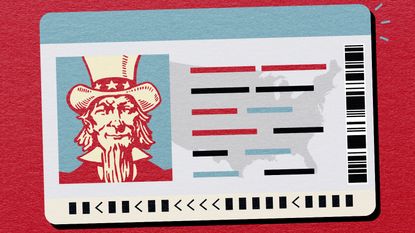
The enforcement deadline keeps getting pushed back, but what exactly is a Real ID?

The deadline for Americans to obtain a Real ID seems to be getting perpetually pushed back. With its enforcement now bumped until 2025, what should Americans be aware of when applying for a Real ID? Here's everything you need to know:
It is a key part of the Real ID Act of 2005. Passed by Congress in the wake of the Sept. 11 terrorist attacks, the act "establishes minimum security standards for license issuance and production," according to the U.S. Department of Homeland Security.
The act also stops certain federal agencies from accepting certain forms of identification, such as a state driver's license or state identification card, because they don't meet these specific requirements.
Escape your echo chamber. Get the facts behind the news, plus analysis from multiple perspectives.
SUBSCRIBE & SAVE
From our morning news briefing to a weekly Good News Newsletter, get the best of The Week delivered directly to your inbox.
From our morning news briefing to a weekly Good News Newsletter, get the best of The Week delivered directly to your inbox.
Per the DHS, people without a Real ID-compliant form of identification cannot access certain federal facilities and military bases, enter nuclear power plants, or most notably, board a commercial flight. Once the law goes into effect, a driver's license or state identification card without a Real ID seal will not be accepted at any airport security checkpoints.
The DHS had planned to begin the Real ID program in 2008, The Washington Post reported. However, Congress did not announce any actual enforcement of the law until 2013. At that time, lawmakers pledged to enact a "phased enforcement plan" of Real IDs, DHS said.
The main impetus for the Real ID Act was the Sept. 11 terrorist attacks. Following that day, the 9/11 Commission was established to investigate the causes of the attacks. In its official report, one of the commission's recommendations was to establish uniform federal standards for all forms of identification documents — particularly those involved in air travel.
"The federal government should set standards for the issuance of birth certificates and sources of identification, such as driver's licenses," the report said. "At many entry points to vulnerable facilities, including gates for boarding aircraft, sources of identification are the last opportunity to ensure that people are who they say they are and to check whether they are terrorists."
In particular, the law was aimed at stopping potential terrorists from boarding flights. The law was especially aimed at domestic travel, where, unlike international flights, people are able to board without a passport. However, while the program has mostly been relegated to the spotlight surrounding driver's licenses, the Real ID Act actually had prongs touching a number of federal guidelines. The majority of these issues concerned immigration.
For one, the act increased the burden of proof required for asylum-seekers to be allowed into the country, though it did eliminate a previously enacted limit on the number of asylum-seekers the U.S. could accept. It also expanded provisions for border security and made it easier for the federal government to deport suspected terrorists.
Many people already have one, as the DHS reports that "half of all the states have already met the Real ID minimum standards." For those that do not, however, they must get a Real ID prior to the deadline, which has been pushed back to May 7, 2025.
Each state has its own system for Real ID applications and administration, and people seeking to obtain a Real ID-compliant driver's license should visit their state's designated website. However, The New York Times notes this has caused some confusion regarding the rollout of the program. Given that each state issues its own cards, the application process varies from state to state. Even the appearance of the IDs themselves are reportedly inconsistent; while all Real IDs are marked by a star, the star's placement differs depending on the state.
There are also various forms of Real IDs, with one notable variant called an Enhanced Driver's License, or EDL. These alternative cards are Real ID compliant, and allow the holder to travel to the U.S., Canada, and Mexico without a passport. Notably, Washington state doesn't even offer its citizens the actual Real ID — they may only apply for an EDL.
Adding to the confusion is the fact that a Real ID may not technically be necessary. According to Passport Health, a company that provides travel medicine and immunizations, "an official U.S. passport will get you through airport security and can be used in place of a Real ID. If you are only traveling domestically, you can use a Real ID or passport." This has been backed up by the DHS itself, which states, "The card, itself, must be Real ID compliant unless the resident is using an alternative acceptable document such as a passport."
The confusing application process, for one. However, there are also more serious controversies surrounding the Real ID program, with some claiming the new IDs would represent a breach of Americans' privacy.
The American Civil Liberties Union argues the Real ID program will turn driver's licenses into "national ID cards," and predicts the fully implemented law would make it easier for the government to track private citizens.
The debate about the Real ID program has been raging almost since Congress put pen to paper. A column in Wired written all the way back in 2005 noted that the bill faced opposition from "hundreds of civil liberties groups, immigrant support groups, and government associations."
Some critics of the Real ID Act also reported that the legislation was actually entered as part of an overarching $82 million spending bill that had authorized funding for the war in Iraq. Given the fierce patriotism that was still gripping the nation in the aftermath of Sept. 11, it can hardly come as a surprise that the entire bill — including the Real ID Act — was swiftly passed without much resistance.
Despite some opposition, it is unlikely that the Real ID Act is going to go away, with DHS saying the program has "significantly improved the reliability and accuracy of state-issued driver's licenses and identification cards." Additionally, DHS Secretary Alejandro Mayorkas said his agency will "implement innovations to make the process more efficient and accessible." This likely means that any frequent flyers may want to get a head start on their Real ID process.